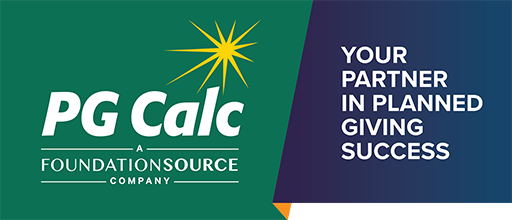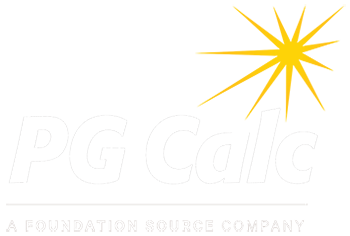Featured Articles
PG Calc publishes monthly articles on the latest topics in planned giving.
New Ruling from IRS Offers 5% Solution for CRATs
-The persistently low IRS discount rates over the past five years has had a chilling effect on charitable remainder annuity trusts (CRATs). One reason is that these low rates have made 1-life CRATs unavailable for beneficiaries younger than their early 70s. Beneficiaries of 2-life CRATs must be even older. The roadblock has been the 5% probability of exhaustion test.
To Retain or Not to Retain? (That is Now the Question)
-Many planned giving programs include retained life estate arrangements (RLEs), whereby the donors contribute their home to the charitable organization, but retain the right to live in the residence for the rest of their lives. These can be tremendously effective examples of a split-interest gift – the charity receives a nice gift in the long run, but the donor derives a substantial benefit first, over a period of many years.
Tracking Gift Annuity Market Values: Unitization v. Fund Accounting
-Charities that permit gift annuity donors to designate how the residua of their annuities will be used must adopt a method of tracking the values of each of their annuities. The Uniform Prudent Management of Institutional Funds Act (UPMIFA), which has been adopted in all states except Pennsylvania, imposes a legal requirement to use restricted gifts in accordance with the instructions specified by the donor. So for gift annuities, this means that if donors are allowed to designate or restrict the use of their gift annuity residua, the issuing charity has a legal obligation to track the market value of each gift annuity.
Even if a charity does not permit gift restrictions on its gift annuities, tracking gift annuity market values allows the charity to monitor the health of its gift annuity program on a gift-by-gift basis, as well as on a pool-wide basis. Gift-by-gift tracking of market values enables a charity to identify individual problem annuities and, once identified, to consider possibilities for ameliorating their negative effect on the performance of the gift annuity program overall.
How High Is the Sky?
-Manager – calls PG Calc Support and asks if there is something wrong with the calculations for deferred charitable gift annuities. “How can the payout rates possibly be as high as 15 or 20% - surely that’s a mistake! Is there something wrong with the software? If not, then, does anybody really write these annuities?”
It turns out there is nothing wrong with the software – the payout rates, as they are expressed, are correct. And yes, charities really do issue these annuities. The problem is in the way the payout rates are quoted. There is an enormous difference between the nominal payout rate of a deferred gift annuity and the effective payout rate of a deferred gift annuity. Let’s take a closer look at how these payout rates work and try to make some sense of it.
Meeting the Challenge of Raising More Planned Gifts
-The challenge grant has been a cornerstone of fundraising for major and annual gifts for many years. Typically challenge grants are structured so that a foundation (or other grant maker) makes a gift to charity upon the charity raising an agreed upon amount of money. Challenge grants have helped nonprofits raise money for capital campaigns and meet other fundraising goals.
Why Websites Still Matter
-Your planned giving website matters in more ways than you can imagine. It has a tremendous impact on how your planned giving program is perceived, and thus, it can be a benefit or detriment.
Planned Giving In a Volatile Market
-The year ending December 31, 2015 was historic and monumental - the earth shifted violently beneath our feet, rivers changed courses, truisms were shattered, and fear was pervasive. Desperate times drove desperate actions, and good men and women scrambled in panic to find stable ground. It suddenly seemed that nothing was safe anymore. No, we’re not talking about the presidential race – we’re talking about the U.S. stock market. For the first time in seven years, the stock market didn’t end the year ahead of where it started. Of the three major U.S. stock indices, two of them ended the year below their price levels on January 1. Flashbacks to 2008 and the Great Recession ensue.
Gift Annuity Risk - Keeping On Your Toes
-During the downturn in the stock market in late 2008, many charities monitored their gift annuity reserve fund balances on a weekly or even daily basis, concerned that there were sufficient reserves to meet the requirements of states with a calendar year reporting period. But the uncertainty brought by the financial turmoil of the “great recession” had at least one positive effect, prompting charities to take a more detailed look at their gift annuity programs, either through an internal review or by hiring an outside consultant. For some, this was the first time a thorough review of the program had been done.
What You Need To Know About IRAs and The “Charitable Rollover”
-There is a lot of talk now in the planned giving community about charitable gifts being made from IRAs (“Individual Retirement Accounts”). In 2006, Congress passed legislation allowing tax-free rollovers from a donor’s IRA to qualified charities. The charitable IRA rollover is one of a number of temporary tax provisions that require annual renewal. These temporary tax provisions are typically extended late in the year and made retroactive to the beginning of that year.
Year End Giving Messaging
-Labor Day signals the end of summer, but it also signals the approach of the season of giving. The last quarter of the year is a busy time in fundraising. Most charities see a significant uptick in giving as December 31 approaches. So how does year-end giving affect planned giving, and how do you make the case that the end of the year is a good time to make all sorts of gifts?

